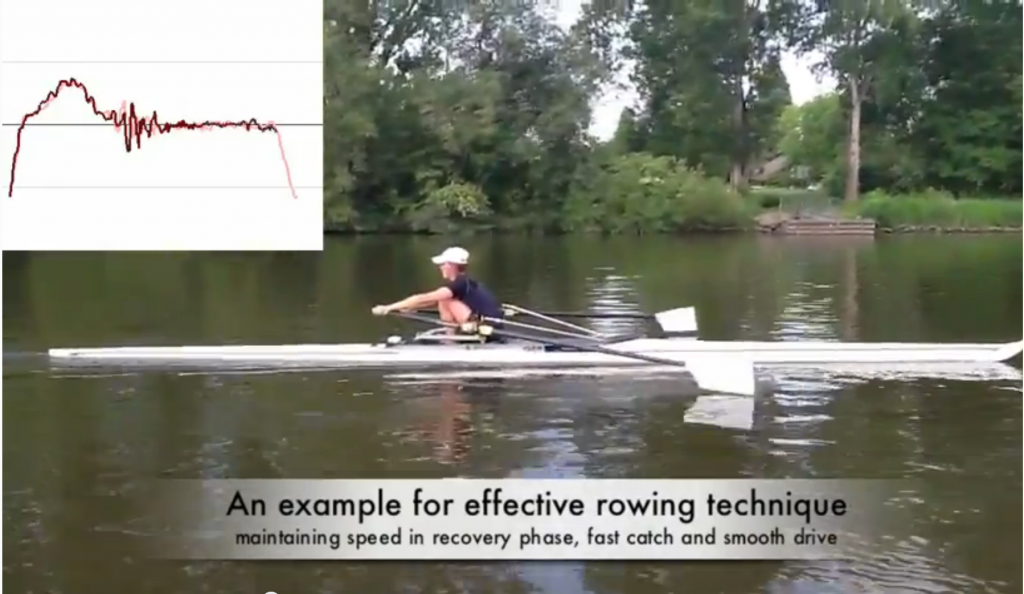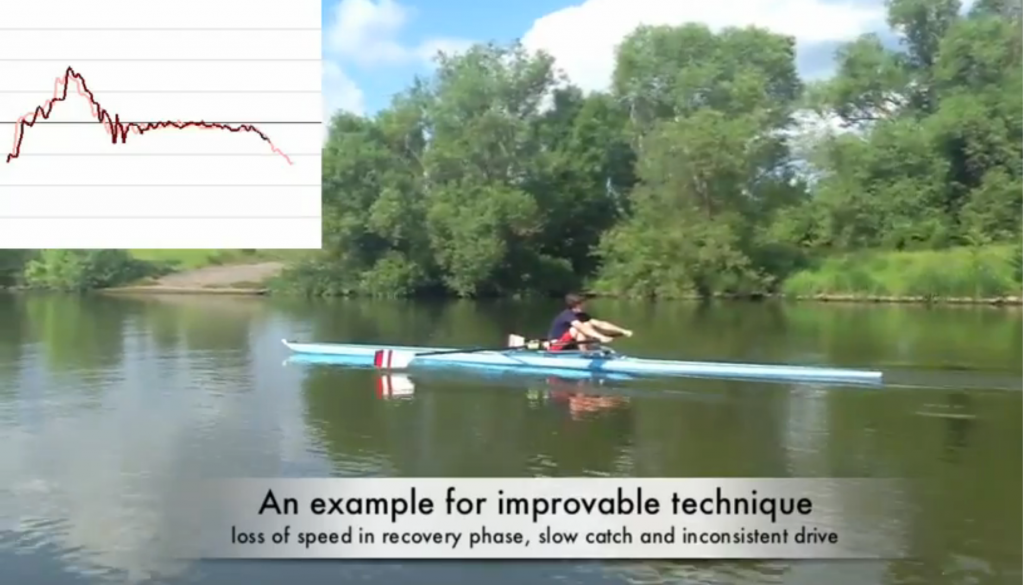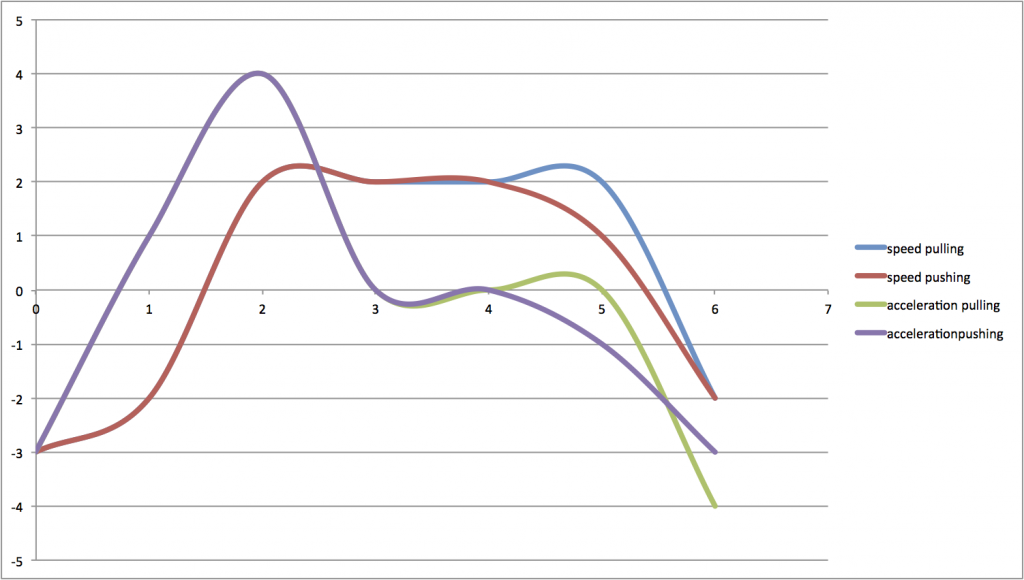Improve your Stroke – maintain boat speed in recovery
This article is partly inspired by an interesting discussion on the decentrowing blog.
In the comments, someone brought up a link to a video by Drew Ginn where he advocates accelerating the sliding seat into the catch. This advice seems to be a bit unconvential considering most coaches advocate a constant sliding seat speed into the catch . Now, Drew Ginn is a very successful athlete and it’s definitely worth listening to his advice. In this post, I’ll explain why Drew is right and how you can use Rowing in Motion to confirm that. I hope this serves as an inspiration how our Rowing Apps can help athletes improve their stroke and row faster.
Speed and the stroke cycle
Rowing boats do not move at constant speed. As the athletes apply force to the boat, velocity changes and that change in velocity is called acceleration. So by looking at acceleration over time , we can make a fair guess what happens to the overall boat speed. A crew will typically achieve the highest boat speed right at the finnish of the stroke as the boat’s been accelerating throughout the drive phase.
What does that imply for the recovery phase? We’ll look at two different rowing techniques and reason about their effect on boat speed.
Pulling on the stretcher
This is the style Drew Ginn advocates and I call “pulling on the stretcher”. After extracting the blades, you try to maintain a steady “pull” on the stretcher. This may even go as far as accelerating the driving seat throughout the recovery phase and “pulling” the boat underneath you. When you pull on the stretcher, you apply a force directed in the boat’s movement direction – the boat will accelerate. Another way to think of this is as a momentum exchange with the boat. Momentum is the product of mass and speed and momentum exchange describes what happens if two coupled bodys (the crew and the boat) change speed. I’ll lie to you a bit and proclaim that the sum of the momentum of the boat and the crew is about zero at any point in time if we discard motion relative to the water. Think you’re rowing in the air or on an ergo with slides. Why zero? Momentum is actually a vector so two momentums can add up to zero if they have the same length but opposite direction. For the sake of the argument, we’ll call the boats momentum positive and the athletes momentum negative.
As the crew accelerates towards the stern it builds up negative momentum, the boat has to accelerate in the opposite direction to build positive momentum. By pulling on the strecher, you will maintain or even increase the boat’s speed towards the catch.If you maintain a higher boat speed, this will also increase your average speed over the stroke cycle. Looking at the picture below, we see a good acceleration throughout the drive phase and then a flat line (= no acceleration) during the recovery phase. This indicates a high boat speed is maintained throughout the recovery phase.
Pushing on the stretcher
“Pushing on the stretcher” is what I call the second style of handling the recovery phase. This is the style I see many athletes apply, even though they aren’t aware of it and for the worse: it’s slow. We’ll start by looking at the finnish and ignore the difference in the acceleration structure of the drive phase (which is a topic of another post). As we can see in this acceleration graph, the rower starts pushing on the stretcher long before the actual catch. Picking up the analogy of momentum exchange again, this means the rower excerts force on the stretcher towards the stern. The athlete slows down his body’s movement towards the stern so the boat has to slow down too to keep the sum of the momentum zero. What effect does this have on boat speed? Because we slow down the boat earlier, we have a decreased average boat velocity.
Comparing “pull” vs. “push” recovery
I have drawn up a quick graph in excel to help you better understand this comparison. It shows the relation between speed and acceleration of both styles of rowing. As you can see, until x=4 all graphs are the same. The “pull” style then continues to maintains a higher boat speed as the “push” style causes negative acceleration and the boat to slow down. The “pull” style comes at the expense of a steeper deceleration at the catch so the start and end speed of both strokes will be similar. What matters though is the average speed over the stroke, which I’ll define as the distance per stroke divided by the stroke duration in seconds. As the distance travelled is the integral under the speed graphs (the area under the speed graphs) and the stroke durations are equal, we conclude that the “pull” style achieves a higher average boat speed. It will bring you to the finish line faster! 🙂
So how can I improve my recovery phase?
A word of caution: how “pull” can turn into “push”
Many rowers trying to apply what I call the “pull” style make the mistake of pulling on the stretcher too hard. They accelerate the sliding seat but then still have to change the crew still has to change movement direction at the catch. This can cause a heavy push on the stretcher at the catch. This is not what it means to apply the pull style. Rather than the intensity of the force applied to the stretcher, these styles differentiate by timing. Correctly applying the pull style means maintaining to pull on the stretcher as long as possible and then having a fast catch.
Measure, feedback, adapt…
You should start trying to apply the “pull” style today. Rowing in Motion can help you measure and verify your progress as you adapt your rowing technique by giving you feedback as you’re in the boat. Helping rowers improve the recovery phase is actually a great use case for sonification as it will allow you to hear when the boat starts slowing down too early. You can use the Coach App to capture a Rowing in Motion video that shows your boat’s acceleration and the crews motion synced
together so you can correlate changes in the motion sequence to changes in acceleration and speed. If you want to see some examples of this in action (including the examples above) you should check out Rowing in Motion on YouTube.
Want to learn more? See what Rowing in Motion can do for you to help you optimize your stroke.
What’s the style of your recovery? What do you teach your athletes? Let me know in the comments.




Here’s more from Drew on this subject…
http://drewginn.blogspot.com/2013/02/rowing-fast-rhythm-flow.html?utm_source=feedburner&utm_medium=twitter&utm_campaign=Feed:+drewginn+(Drew+Ginn)&m=1
Thanks for sharing Mike!
A higher boat velocity towards the catch means a lower velocity on the crew on the same time. It would be interesting to see a graph from the system (boat and crew), not only the boat speed. It just looks as this pull gives the crew the excuse to get away with a slow (and mabye mis timed) catch. A higher boat speed (in point x=4 to x=5.5) means also a greater restistance between boat and water in the same time. Since this is right before the catch it means that the acceleration must be higher when doing “pull” compared to “old style” rowing. Care to elaborate?
The graph in the article is purely illustrative. Let me address your points one by one:
->”A higher boat velocity towards the catch means a lower velocity on the crew on the same time.”
That is correct, due to conservation of momentum. The system (rower+boat+oars) velocity is only determined by forces acting between that system and its environment (air and water).
-> “It would be interesting to see a graph from the system (boat and crew), not only the boat speed.”
Absolutely, but measuring this (accurately) is very difficult, because you’d need to know the position of the center of mass of the crew
-> “It just looks as this pull gives the crew the excuse to get away with a slow (and mabye mis timed) catch.”
Not at all. When you pull on the stretcher throughout the recovery, you actually have less time to prepare for the catch as you’re not “slowing down” the sliding seat into the catch. It’s a much quicker reversal.
-> “A higher boat speed (in point x=4 to x=5.5) means also a greater resistance between boat and water in the same time”
Yes, that is correct. The figure in the article is purely for illustration purposes and does not accurately reflect what would happen in a real boat. I have since published an article where you can better see this: http://www.rowinginmotion.com/comparing-boat-speed-for-three-common-rowing-mistakes/ Not standing on the stretcher increases fluid-drag efficiency because the variation of boat velocity is reduced. This results in a higher average speed because less work is lost to fluid drag.
“Since this is right before the catch it means that the acceleration must be higher when doing “pull” compared to “old style” rowing. Care to elaborate?”
-> You will find that with the “pull” style peak negative acceleration is much larger than with the push style, as the momentum that needs to be exchanged is roughly similar. What you want to do in the recovery really is try and minimize velocity fluctuations as far as that’s possible (at high strokerates you will see the boat accelerate in the recovery, but that’s a matter for another post).
HI, I love the learning and discussion your work enables. I wanted to add my little bit into the fray about maintaining boat run throughout the recovery phase. The first 1/4 of the recovery is the most important. You have to get the bulk of your upper body weight over to maintain ‘centred’ with the boat run. In coaching terms you need to rock over. Then you can roll up the slide in harmony with the boat run. What most people don’t do is enable this rock over. What? Well, try and lock your knees down (as you must do to hold the finish position) and touch your toes. Now repeat this after softening your knee caps. Your hamstrings are now free and you will be able to rock and reach! Build this into the recovery and your boat run will improve. Now, I am basing this on my experience as a rower – ten years on the Australia team, world champion in scull and sweep boats and now ten years of coaching all sorts of rowers. I am going to get your app and go out and do some testing! Pulling up the slide may well work at the highly skilled end but for most crews presents many dangers! (hitting front chocks, missing the placement type of dangers. Love to know if anyone is trying to teach the pull recovery and having success with it.
Do we sit at the finish and let the boat run, or do we move with the boat run, then roll with the run? Do we want the wheels to keep turning at the same speed up the slide or do we want to accelerate them into the front, accelerating the boat as we do this?
Happy rowing!
Great article, I would love to see more articles on drills that may help elaborate on this concept, especially with 1st and 2nd year rowers. Would you be willing to email me? Thank you in advance, I appreciate your insight!
I’ve never seen any crew in regattas really go for a “pull recovery”. That just creates stern check.
“Pull recovery” does not mean accelerating into the catch. What it means is that the crew tries to maintain boat speed constant by exchanging momentum with the shell, while the total system (crew + boat) looses energy due to friction of the shell in the water. This creates a more drag-efficient recovery, see https://www.rowinginmotion.com/drag-efficiency-rowing/
I hate to shatter most rowers’ beliefs about the recovery, but what people need to understand is that ALL rowers accelerate their seat On the slide in the recovery AT RACE PACE. This is unavoidable. In fact, it is this acceleration that indicates a positive acceleration on the boat (which is a good thing). The idea that you are constant in speed on the slide, or even slowing down the slide is seriously misplaced.
If you are unsure about this then you need to analyse the acceleration curve of rowing boats AT RACE PACE. You will be enlightened.
At the end of the day, rowing speed (or lack of it) is produced by a series of forces from the rower(s) acting on the boat.
Horizontal positive forces on the foot stretcher while the blade is in the water accelerate the boat. Horizontal Negative (i.e. “Pulling” forces) on the foot stretcher during the recovery accelerate the boat.
Any positive (pushing) force on the stretcher while the blade is out of the water will decelerate the boat.
Any vertical force on the boat will decelerate the boat.
What is most important at the catch is minimising the TIME you spend with force on the stretcher without the blades in the water. This is the key to boat speed.
Many rowers need to get over their long held beliefs and truly understand what is really going on when we take a stroke.
Jane,
You make some great points re softening the knees on the recovery. This is a great way to feel the run of the boat and allow and fluid, relaxed movement.
I don’t really understand the fear about pulling on the stretcher during the recovery. The reality is that almost every rower/crew in the world does this at race pace whether they know it or not, although some do it better than others. If you don’t believe me then take a look at biomechanics including foot stretcher forces.
I have worked with world leading Biomechanists that have analysed the data from many top crews (including Olympic champions) and the message is clear – the best rowers create negative (I.e pulling force) on the stretcher during the recovery.
The very best ones maintain this negative force until very late before the catch (around 15 deg before catch). This enables them to keep accelerating the boat for longer and thus carry a higher speed on the hull into the catch. Now all rowers/crews will decelerate the boat before the catch – this is unavoidable. However, the Best crews do this for a very short period of time before they create positive acceleration in the drive. Interestingly, often the better crews have a higher magnitude of deceleration at the catch, but they do it for a much shorter period of time than less accomplished crews. This allows the boat speed to remain higher each stroke.
I hope this makes sense.